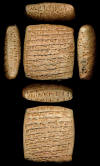World Heritage Site: Kültepe

Kültepe (Turkish: "Ash
Hill"), also known as Kanesh or Nesha, is an archaeological site in
Kayseri Province, Turkey. The nearest modern city to Kültepe is Kayseri,
about 20 km southwest. It consists of a tell, the actual Kültepe, and a
lower town, where an Assyrian settlement
was found. Its ancient names are recorded in Assyrian and
Hittite sources. In Old Assyrian
inscriptions from the 20th and the 19th century BCE, the city was
mentioned as Kane (Kanesh); in later Hittite inscriptions, the city was
mentioned as Nea (Nesha, Nessa, Nesa), or occasionally as Ania (Anisha).
In 2014, the archaeological site was inscribed in the Tentative list of
World Heritage Sites in Turkey. It is the place where the earliest
record of Hittite, dated to the 20th century BCE has been found.


Kane or Nea, inhabited
continuously from the Chalcolithic to Roman
times, flourished as an important Hattian, Hittite and Hurrian city,
containing a large kārum (merchant colony) of the
Old Assyrian Empire from c. the 21st to 18th
centuries BC. This kārum appears to have served as "the
administrative and distribution centre of the entire Assyrian colony
network in Anatolia". A late, circa 1400 BCE record recounts the story
of a king of Kane called Zipani with seventeen local city-kings who
rose up against Naram-Sin of Akkad who ruled circa 22542218 BC.


During the kārum period, and before the conquest of Pithana, these local
kings reigned in Kane:
- Hurmili (before
1790 BC)
- Pahanu (a short
time in 1790 BC)
- Inar (c. 1790-1775
BC), then
- Warama (c.
1775-1750 BC).[4]
The king of Zalpuwa,
Uhna, raided Kanes, after which the Zalpuwans carried off the city's
iu idol. Pithana, the king of Kussara, conquered Nea "in the night,
by force", but "did not do evil to anyone in it." Nea revolted against
the rule of Pithana's son, Anitta, but Anitta quashed the revolt and
made Nea his capital. Anitta further invaded Zalpuwa, captured its king
Huzziya, and recovered the iu idol for Nea.


In the 17th century BC, Anitta's descendants moved their capital to
Hattusa, which Anitta had cursed, thus founding the line of
Hittite kings. The inhabitants
thus referred to the Hittite language as Neili, "the Nea tongue".
Kârum Kane
The quarter of the city
that most interests historians is the kārum, a portion of the city that
was set aside by local officials for the early Assyrian merchants to use
without paying taxes as long as the goods remained inside the kārum. The
term kārum means "port" in Akkadian, the lingua franca of the time, but
its meaning was later extended to refer to any trading colony whether or
not it bordered water.
Several other cities in Anatolia also had a kārum, but the largest was
Kane, whose important kārum was inhabited by soldiers and merchants
from Assyria for hundreds of years. They traded local tin and wool for
luxury items, foodstuffs, spices and woven fabrics from the Assyrian
homeland and Elam.
The remains of the kārum form a large circular mound 500 m in diameter
and about 20 m above the plain (a tell). The kārum settlement is the
result of several superimposed stratigraphic periods. New buildings were
constructed on top of the remains of the earlier periods so there is a
deep stratigraphy from prehistoric times to the early Hittite period.
The kārum was destroyed by fire at the end of levels II and Ib. The
inhabitants left most of their possessions behind, as found by modern
archaeologists.
The findings have included numerous baked-clay tablets, some of which
were enclosed in clay envelopes stamped with cylinder seals. The
documents record common activities, such as trade between the Assyrian
colony and the city-state of Assur and between Assyrian merchants and
local people. The trade was run by families rather than the state. The
Kültepe texts are the oldest documents from Anatolia. Although they are
written in Old Assyrian, the Hittite loanwords and names in the texts
are the oldest record. Most of the archaeological evidence is typical of
Anatolia rather than of Assyria, but the use of both cuneiform and the
dialect is the best indication of Assyrian presence.
Dating of Warama Sarayi
At Level II, the
destruction was so total that no wood survived for dendrochronological
studies. In 2003, researchers from Cornell University dated wood in
level Ib from the rest of the city, built centuries earlier. The
dendrochronologists date the bulk of the wood from buildings of the
Warama Sarayi to 1832 BC, with further refurbishments up to 1779 BC. In
2016 new research using carbondating and dendrology on timber used in
this site and the palace in Acemhöyük
show the likely earliest use of the palace as not before 18511842 BCE
(18551839 BCE). In combination with the many Assyrian objects found
here, this dating shows that only middle or low-middle chronology are
the only remaining possible chronologies that fit these new data.
Multi-Lingual Cultural
Tour Operator TransAnatolie Tour is a member of
-
Turkish Ministry of Culture and Tourism (A
Group Licence
No. 4938)
-
Ankara Chamber of Commerce (Trade registry under
No. 54/1024)
-
Turkish-French Cultural Association
-
Turkish Association at the United Nations
-
Union of Turkish Tour Operators (TÜRSAB)
-
Union of Multi-Lingual Professional Tourism Guides (TUREB-ARED)
-
Ankara Cultural Tourism Association (BATUDER)
-
Nigde Cultural Association
-
Aksaray Cultural Association
-
Arts & Cultural Association of Taspinar.
TransAnatolie info-webs
(pages):
On these webs you will find background
information about our company, our offices, our current job offers and more info
about current and future products and services.
If you could not find the information you need on these pages and/or
on our other
pages, or for inquires please do not hesitate to contact us at:
info[at]transanatolie.com

-
TransAnatolie Tour
-
Multilingual Cultural Tour Provider and Operator
- A - Group
License N°4938 - The Turkish Ministry of Culture and Tourism
|
